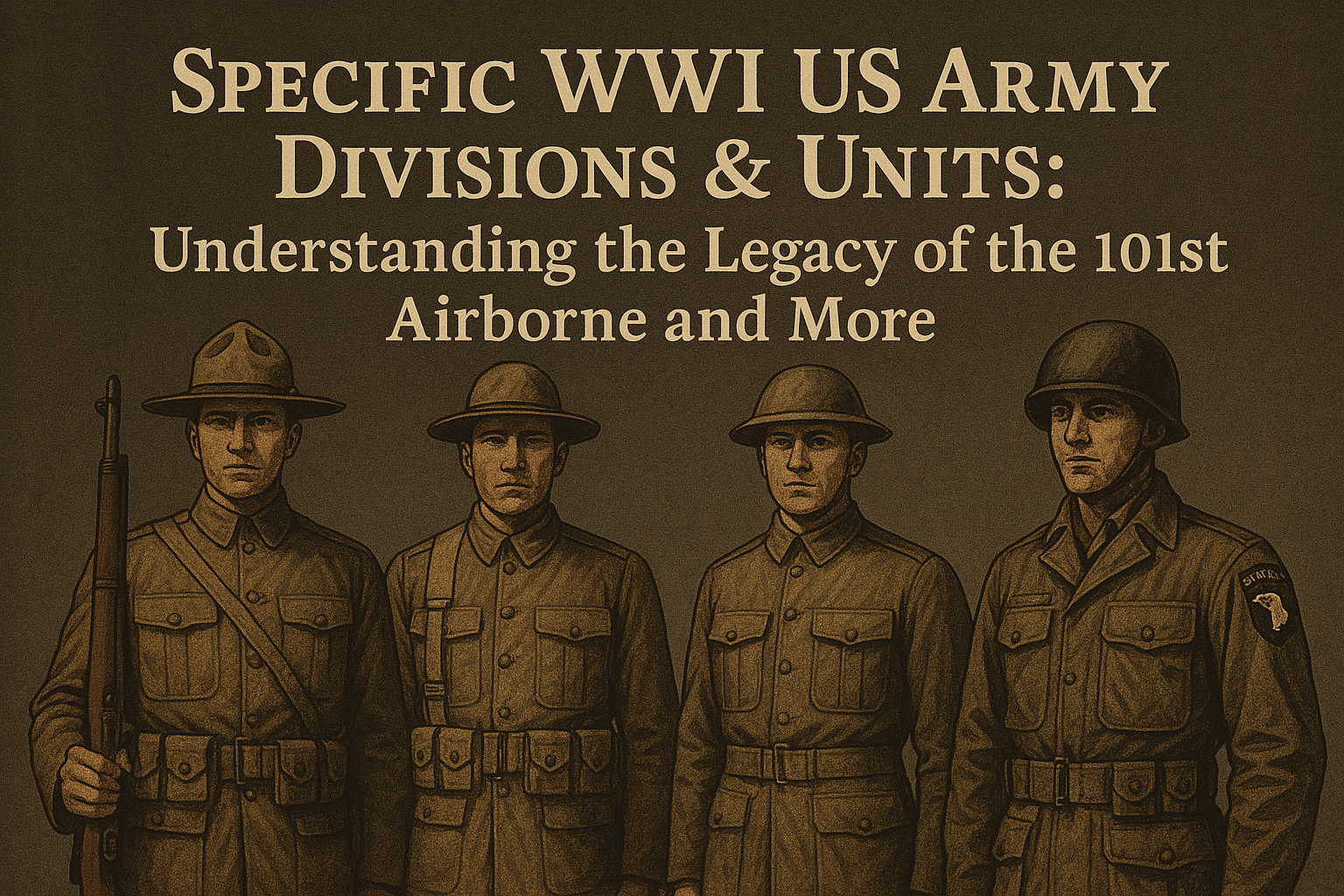
Specific WWI US Army Divisions & Units: Understanding the Legacy of the 101st Airborne and More
Published on Mar 26, 2025
Introduction: The Significance of US Army Divisions in WWI
World War I was a defining moment in military history, with the US Army playing a crucial role in the defeat of the Central Powers. The US Army's divisions and units were instrumental in changing the course of the war, and many of these units went on to become legendary for their bravery and contribution to global peace.
While WWI uniforms are often overshadowed by those worn in subsequent conflicts like WWII, they laid the groundwork for the distinctive military clothing that would become iconic, including those associated with the famous 101st Airborne Division. Known as the "Screaming Eagles," the 101st was not only instrumental in WWII but also represented the evolution of American military uniforms and their role in iconic battles.
In this blog, we'll take a closer look at specific WWI US Army divisions and units, particularly focusing on their uniforms, key battlegrounds, and legacy. We'll also explore how these early influences shaped later units like the 101st Airborne.
A Glimpse into the WWI US Army Divisions
WWI saw the deployment of numerous divisions by the US Army, each with unique contributions to the war effort. Among the most notable were the 1st Infantry Division ("The Big Red One") and the 42nd Infantry Division ("Rainbow Division"). These units helped to introduce new tactics and cement the US Army's role on the world stage.
1st Infantry Division ("The Big Red One")
The 1st Infantry Division was the first full division deployed to Europe during WWI. They played a critical role in the Battle of Cantigny in 1918, which was the first major American victory in the war. The Big Red One was known for its disciplined structure, and their uniforms were designed to stand out, with a large red number "1" symbolizing their distinction.
42nd Infantry Division ("Rainbow Division")
Another famous unit during WWI was the 42nd Infantry Division, also known as the "Rainbow Division." Their name came from the colourful mix of states represented in the unit. The Rainbow Division fought in key battles like the Meuse-Argonne Offensive, where they helped secure critical victories. Their uniform was characterized by a more diversified look, given the varied regions from which the soldiers hailed.
These divisions were among the first to adopt standardized uniforms, which played a role in shaping military fashion in the years that followed.
WWI US Army Uniforms: The Evolution of Military Fashion
The design of US Army uniforms evolved, with the goal of providing soldiers with the right gear for combat while also fostering a sense of unity. The WWI US Army uniform had a distinctive, practical look, with key components like wool trousers, tunics, and the iconic M1912 field cap. These uniforms were designed for rugged trench warfare, with deep pockets for carrying essential supplies.
Despite the practical purpose, the uniforms were still elegant and professional, and as combat styles changed, so did the uniform designs. In the post-WWI era, these early uniforms influenced later designs, including those worn by the 101st Airborne during WWII.
The 101st Airborne Division: Legacy of Bravery and Uniform Evolution
The 101st Airborne Division was officially activated during WWII, but its roots can be traced back to the experiences of WWI. In fact, many of the soldiers who fought in the early years of the 20th century contributed to the eventual formation of the division that would become known for its valour on D-Day and the Battle of the Bulge.
The WW2 101st Airborne Uniform
The WWII 101st Airborne uniform was distinctive, with a focus on both mobility and protection. The uniform consisted of a standard wool tunic and trousers, but it featured an iconic helmet and distinctive patches, such as the "Screaming Eagle" insignia. The uniform was designed to be highly practical and tailored for paratroopers who needed lightweight and effective clothing for airborne operations.
The transition from WWI to WWII saw several changes militarily. The introduction of paratrooper boots and jump jackets in the 101st Airborne uniform reflected a new approach to warfare that required more flexibility and agility.
Uniforms Beyond WWI and WWII: A Continuing Legacy
The influence of WWI-era uniforms continued to shape military clothing in subsequent years. During the years following the Great War, white uniforms became a significant part of military regalia, particularly in ceremonial events and important functions. These uniforms were designed for formality, representing the prestige and honour of the military service.
In addition to dress whites, the Army Evening Dress Uniform evolved from earlier versions, with a more formal, polished look that carried the heritage of past wars. These uniforms continued to incorporate elements from WWI, maintaining a sense of continuity and respect for military tradition.
Conclusion: The Timeless Legacy of WWI US Army Divisions and Uniforms
The legacy of the US Army divisions during WWI is still felt today, from the iconic 101st Airborne to the enduring design of their uniforms. These units played pivotal roles in shaping both military tactics and the visual identity of the US Army. The WWI era was a time of great transformation, with uniforms evolving to meet the demands of modern warfare.
Whether you're interested in the history of the WW2 101st Airborne uniform, the battle-hardened legacy of units like the Big Red One, or simply the evolution of military dress, these divisions and their uniforms are a testament to the courage and sacrifice of American soldiers during one of the most pivotal periods in history.
